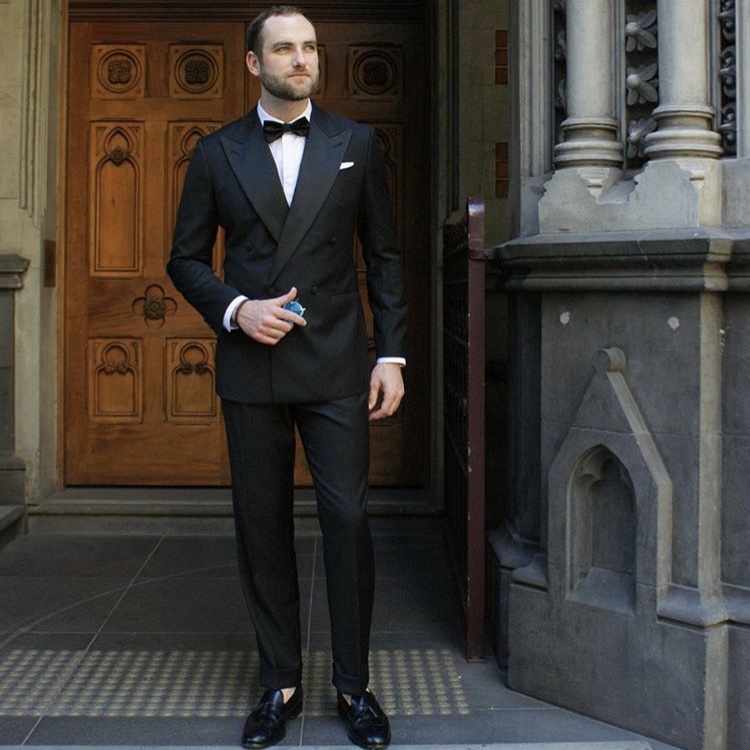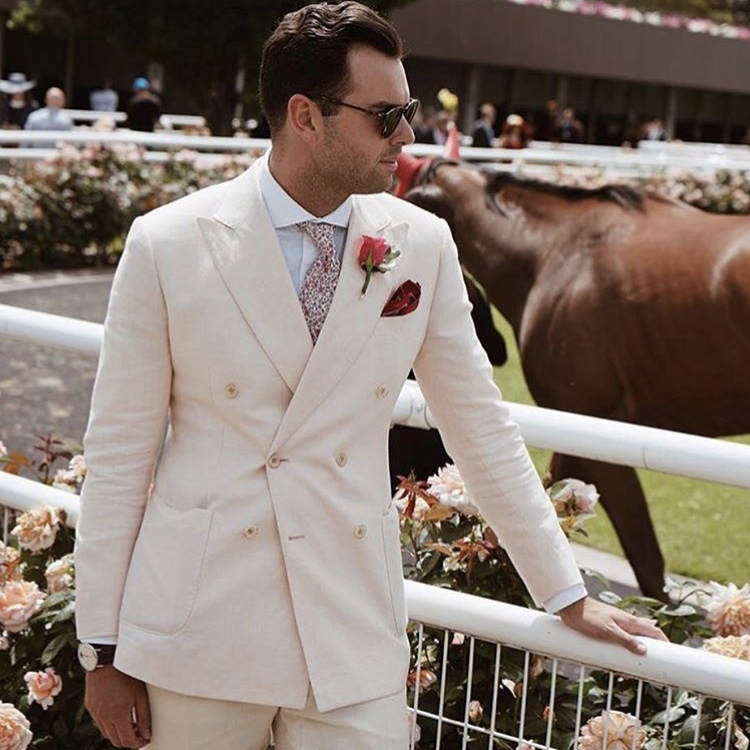Men's Dress Codes: Explained
It’s always exciting when an invitation arrives for a wedding or ball. But there’s usually some confusion over the dress code. It would be a nightmare to arrive underdressed in the wrong ensemble looking like a peanut. But fear not, in this article Sam explains the dress codes black tie, formal, lounge suit and smart casual to help you look appropriately dressed for next the big event.
Black Tie
The most sophisticated dress code of all. Tuxedo, dinner suit, smoking jacket.. whatever you prefer to call it.
Traditionally, worn at night time, the jacket should have peak or shawl lapels and is often paired with a crisp white shirt, a black bow-tie, white square and patent black shoes.
This dress code gives is your opportunity to don a tuxedo. Whether it be black wool, a white silk or green velvet, a made-to-measure dinner jacket can do you no wrong.
My advice to clients is always to chose black for your first. Once you’ve had the black, experimenting with colours like midnight navy and maroon are great choices to stand out.
The jacket fastening can either be single-breasted (which allows for a cummerbund) or double breasted. The single breasted jacket usually has only 1 button. The double breasted is usually 2, 4 or 6 buttons.
Traditionally, a dinner jacket should have no back vents.
Pair it with black trousers that are cuffed or straight with the satin stripe down the side (often made from the same fabric as your jacket lapels), taking elegance to the next level.
Your fitted white shirt should have French cuffs giving you the opportunity to add cufflinks to the ensemble. The best shirt options include a decorative bib with pleats down the front, concealed buttons, or mother of pearl or black stud buttons. My personal favourite is a concealed button placard for a super clean look.
You cannot, of course, forget the bow tie. A bow-tie with an unusual texture can never go astray. However, my advice is to stick to black bow-tie, and real ones (rather than pre-tied) always look best. Compliment your ensemble with a white pocketsquare to keep things classic.
Finally, a pair of black patent shoes, high shine leather, pumps, or velvet loafers are appropriate. When the time comes to remove your jacket, black suspenders work brilliantly as another detail in your arsenal.
Cocktail (Formal)
To meet the dress code of Cocktail/Formal, you must wear a suit that can be worn both during the day, for a long lunch, and in the evening for an aperitif. Like for a black tie event, a well-fitted suit is required.
A matching blazer and trousers will do the job perfectly. Light and summery fabrics such as linen, in a peach or egg-shell blue for a luncheon or darker, heavier fabrics in colours such as navy, for that moody look needed for a cocktail party.
You should wear tie, but remain slightly more traditional in your choice. A pocket square is also much needed for this dress code.
Lastly, either tan coloured monk-strapped shoes or black matte tasselled loafers will be a lovely finishing touch.
Do NOT wear shorts, sneakers, denim or any other experimental garments for a formal event.
Lounge Suit
Despite the name insinuating that this dress code is for drinks on a suede sofa, the ‘lounge suit’ dress code actually refers to business attire.
‘Lounge suit’ should more or less be treated the same way as your ensemble for the Spring Races.
What separates your normal work suit for the office and lounge suit is that you’re required to add more flavour through accessories such as squares and slightly bolder ties.
Black, grey or navy suits are fine for this dress code, although other colours are welcome. You can keep things interesting with a nice pin stripe or a Prince of Wales check.
Both double or single-breasted jackets can be worn and a double pleated trouser can add an element of classic style. A pale sky-blue shirt, instead of a white shirt can set you apart from the rest too.
Despite being not quite as dressy as formal/cocktail, a tie is still required. Again, as the suit will most likely be in grey or navy blue, you can further individualise the look with a lovely Italian silk tie in paisley or a collar bar for extra spice.
Dress shoes are also still essential, however, the design and the wearing of socks or no socks, is entirely up to you.
Smart Casual
For this dress code, you should tone things down with a more casual and relaxed suit, or suit separates.
A tie is NOT worn for this dress code, however, you may chose to wear a cravat. A plain pocket-square can be added.
A good way nail the ensemble is to chose different colours for trousers and jacket respectively. If you go down this path, an easy way to nail it is by choosing plain tailored trousers paired with simple patterned blazer (such as subtle window pane or herringbone).
The blazer is often worn open.
If going for a suit, aim for more relaxed/summer colours and fabrics to make it slightly less formal. After all, you don’t want to look like heading into to the office.
The top two buttons on the shirt should also be worn undone. Casual loafers or dress sneakers, with or without the socks, will complete this look.
Nail the Dress Code
When an invitation arrives for the next event make sure you follow these tips to ensure you look appropriately dressed. Most importantly, make sure that your suit is tailored well and fits you properly. All gents pictured are wearing made-to-measure garments by Samuel Diamond.










